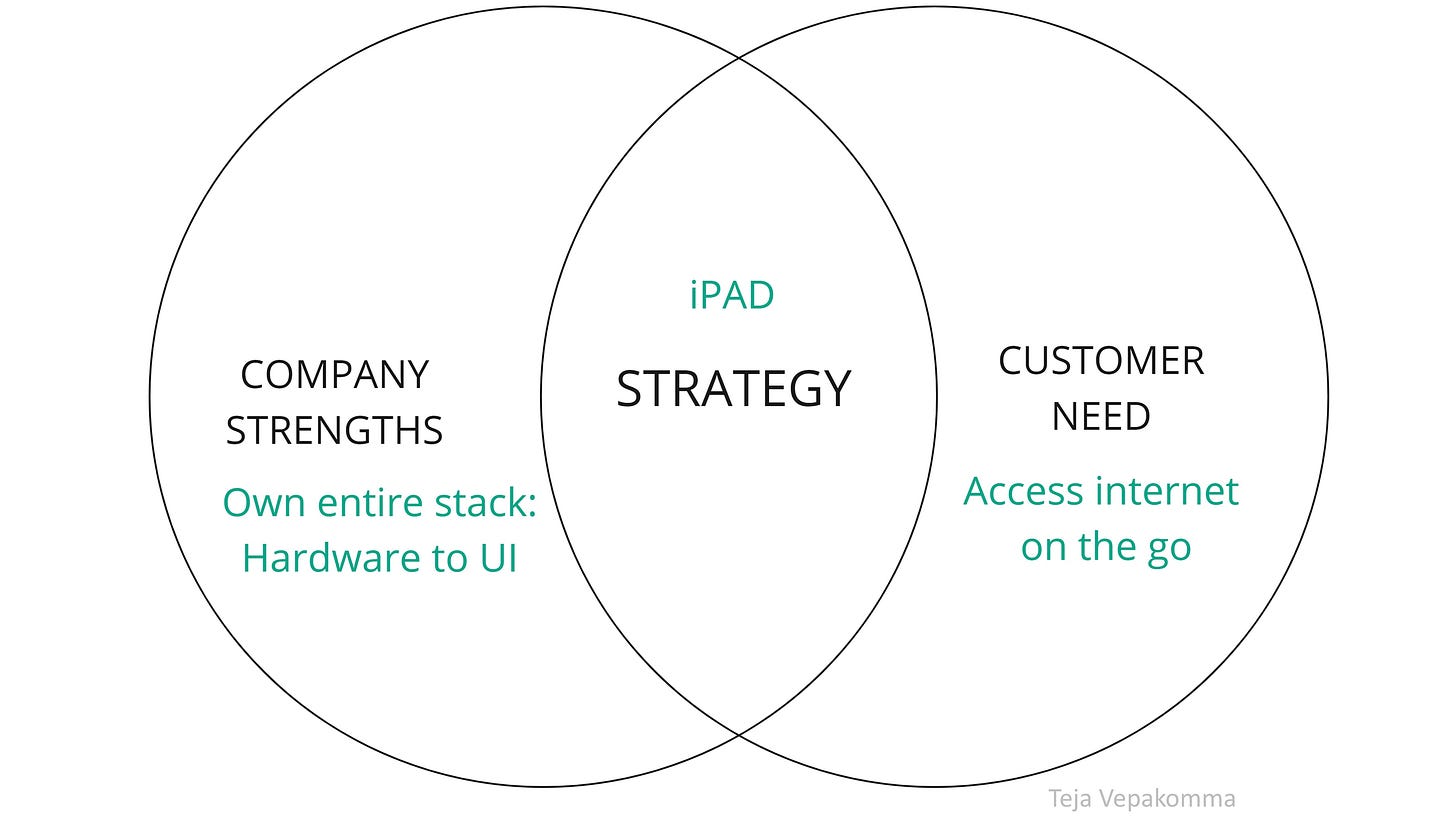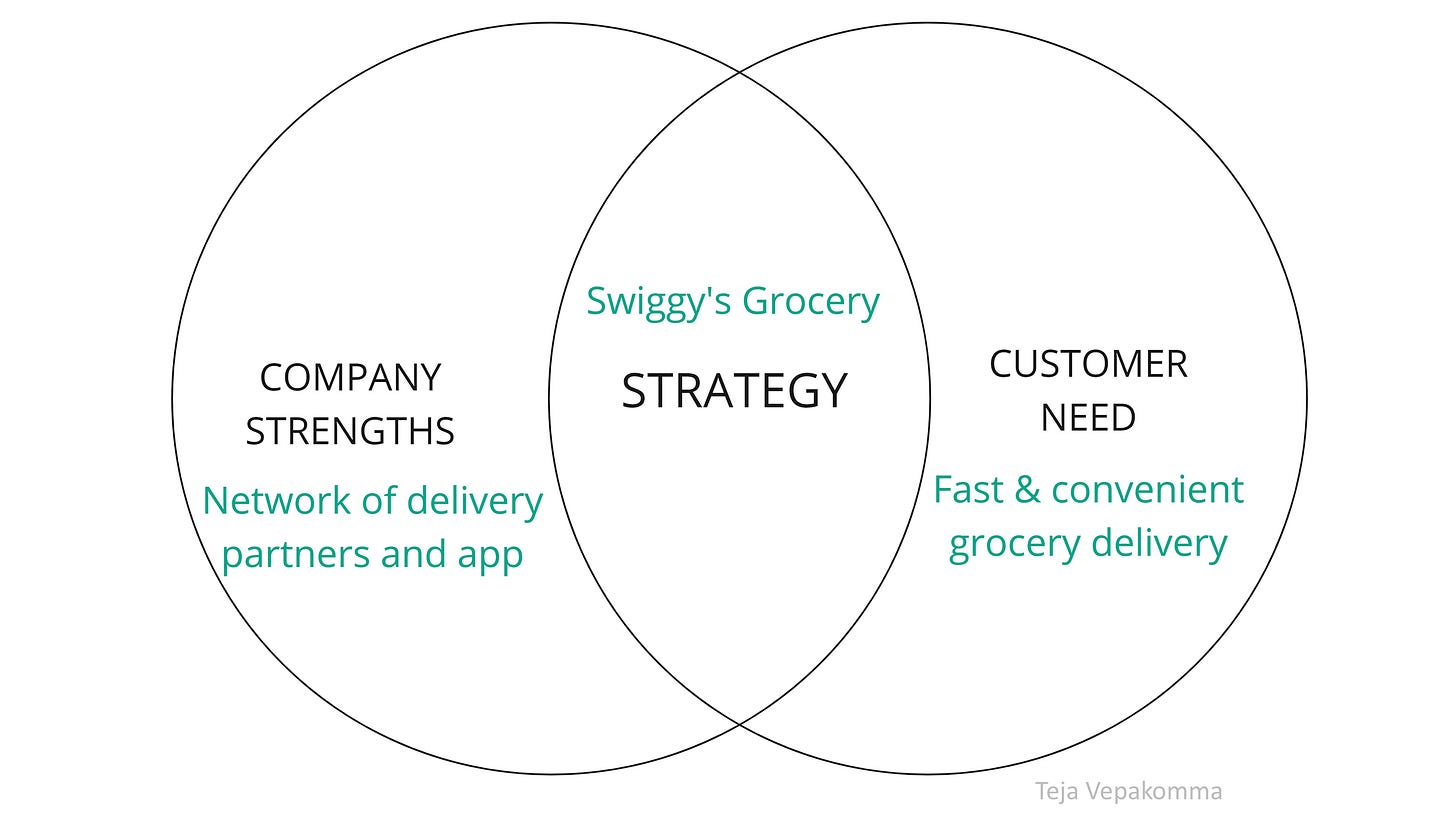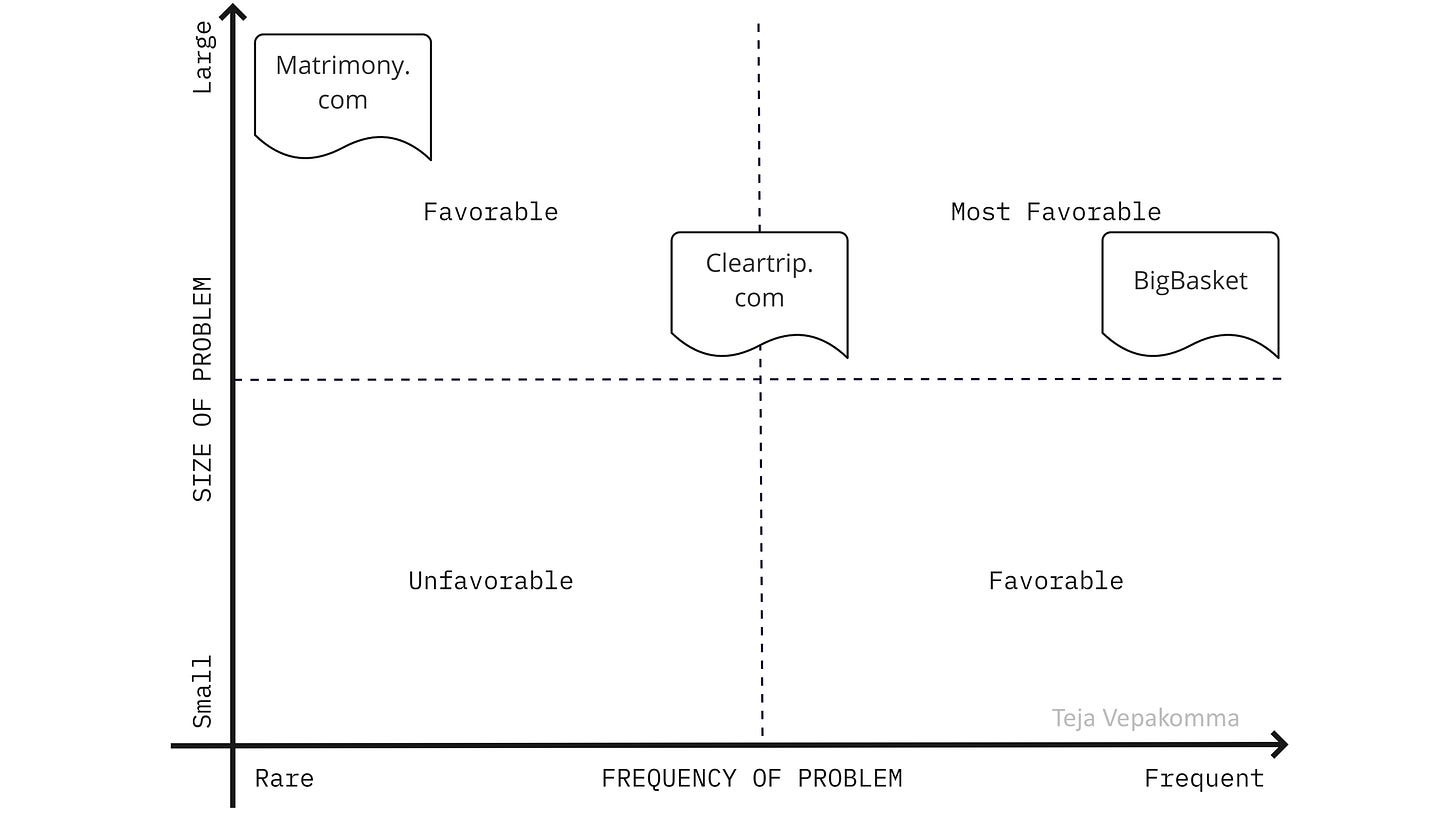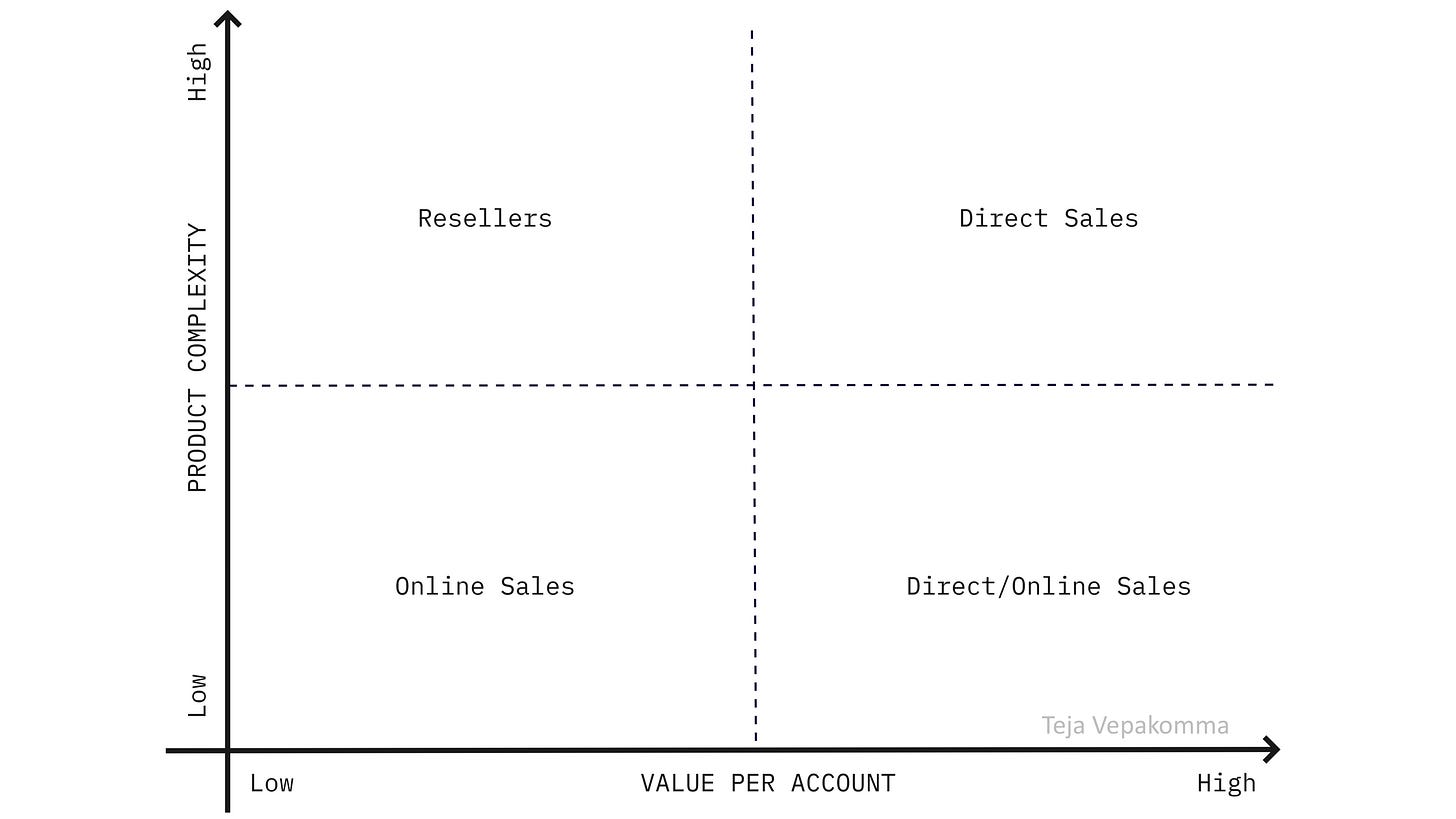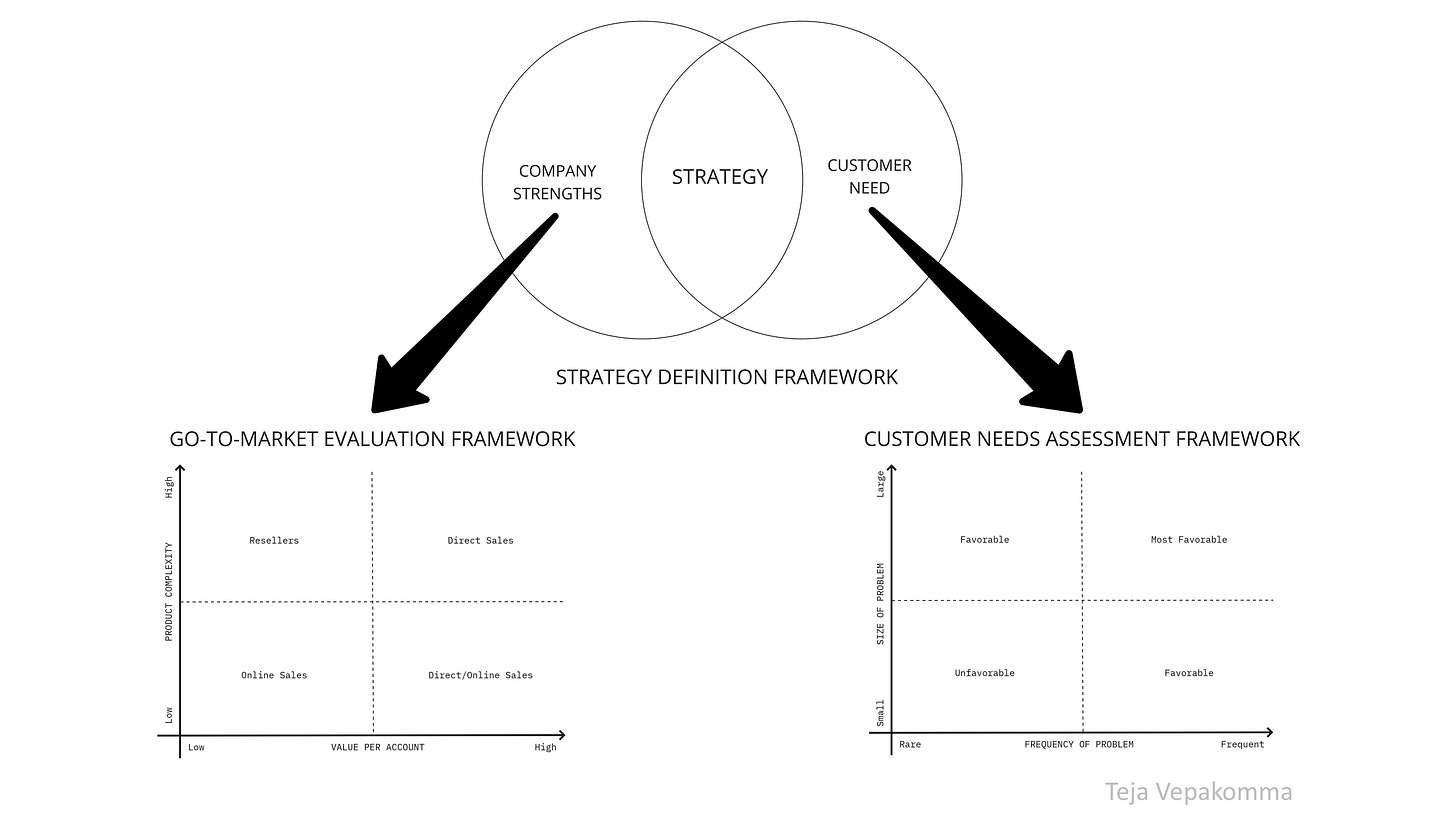A simple, yet powerful way to think about Strategy
Business Strategy doesn't have to be complex, it needs 2 key ingredients. Read on..
A clear strategy, communicated across the company, ensures everyone is working toward the same goals. Without it, teams may head in different directions, weakening overall progress.
Thinking about your business strategy doesn’t have to be complex. Here, I will present a structured way to think about strategy.
Defining Strategy
Business Strategy - according to me - is simply defined as bringing together the firm's best strengths to solve a customer problem. Notice there are two elements here:
1) Firm’s strengths
2) Customer problem
The bringing together of these two elements is the company's strategy. The bigger (and more unique) the firm’s strengths and the bigger the customer problem, the more solid the strategy will be.
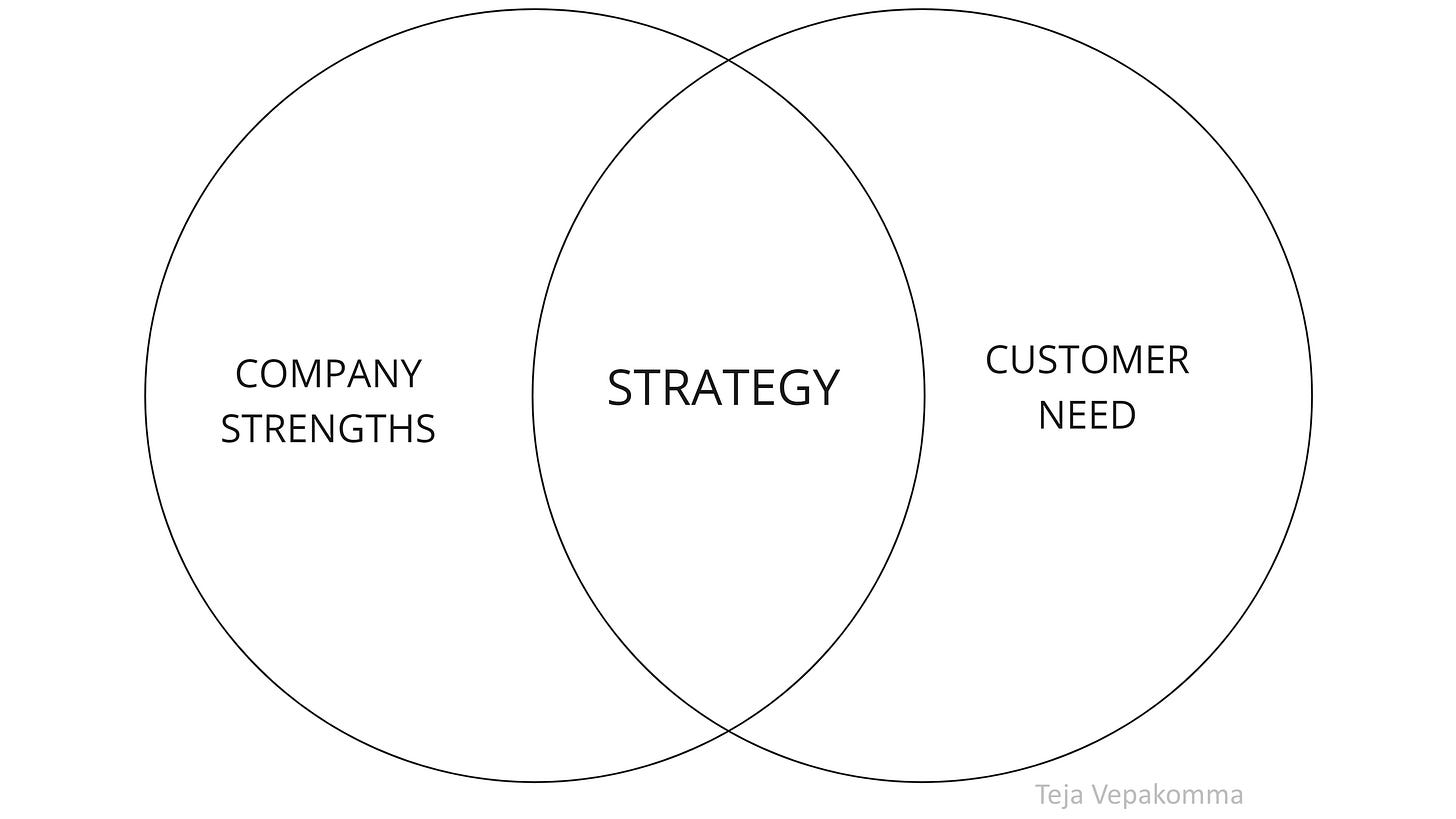
Answering “What’s the strategy?”
Every time you are asked, “what’s the strategy?”. Your response should be “Customers really need XYZ. Our company’s unique strength is ABC. Hence our strategy is use our strength ABE to solve XYZ customer problem”.
Example 1
Let’s take a simple example: The iPad. In this case, Apple’s strength is ownership of the entire technology stack from hardware to operating system to the user interface. Customer need here is to access the internet on the go. Building a solution to this customer need will require innovating on the hardware, software as well as the user interface to ensure optimal experience, and performance. Which company is uniquely suited to solve every component of this problem stack? It is Apple. Competitors will not be able to replicate Apple’s success because they don’t own all components of this stack.
Hence in this case, the company’s strength is really helpful and unique providing it a competitive advantage. Therefore, this strategy for iPad is strong.
Example 2
As another example, consider the problem of whether or not the food delivery company Swiggy must venture into grocery delivery.
We break down this strategy problem into two parts:
Company strengths: Swiggy’s strength is its vast network of delivery partners who fulfill customer orders in minutes. Swiggy has already built this network for food delivery. The same network can be used to deliver groceries also. Similarly, Swiggy app is convenient to use (instead of dictating the grocery order over phone to the nearby grocery store).
Customer need: There is no doubt that customers have a need to get groceries delivered on time and in a convenient fashion.
Putting the two together, Swiggy’s unique strength (barring competition from the likes of Zomato) can be put to good use to solve customer’s need for instant grocery delivery. This is another example of a solid strategy.
Customer needs assessment
Strategy is about bringing together the firm’s unique strengths to solve a customer problem. The two elements of a good strategy are 1) Firm’s strength 2) Customer need. In this section, let’s deep dive into the second aspect which is customer need.
How do we identify customer needs? How do we know we are solving the right problem? We can think of a customer problem along two dimensions: size of the problem and frequency of the problem.
In the customer needs assessment framework, we determine if a customer problem is rare or frequent (horizontal axis) and small or big (vertical axis). If there are multiple customer problems being considered, all of those problems can be plotted on this 2x2 framework. This framework becomes a handy framework for product feature Prioritization as well.
Customer problems that fall on the top right of the 2x2 matrix are the most favorable to solve as they are frequent and large problems that customers will be willing to purchase a solution for.
Consider the following three businesses:
BigBasket - A grocery delivery platform
Matrimony.com - An online match making portal
Cleartrip.com - A travel booking site
If we arrange these businesses on the customer needs matrix, they will look something like this:
Matrimony or finding a suitable match for marriage is no doubt a big problem, but it is fairly infrequent (hopefully!). On the other hand, booking a flight (Cleartrip example) is fairly more frequent. Ordering groceries (BigBasket) is the most frequent.
Features or business opportunities that lie withing the top right of the matrix are the most favorable ones to invest in.
Company strengths assessment
The second element of a good strategy is to see if there are unique company strengths that can be leveraged to solve a customer need. Some of the unique company strengths include:
Existing go-to-market channel to serve the target customer
Bundling with existing products
Let’s look at these in detail.
Existing go-to-market channel
It takes time to build a distribution channel to reach customers. The distribution channel can be:
Direct marketing (Website, Ads) - In the case of B2C segment
Direct sales (own sales team) - In the case of enterprise segment
Channel sales (reseller network) - In the case of SMB segment
Each of these channels requires time, effort and money to build. Distribution channel is one of the key strengths of a company.
While evaluating potential new investments, it gives a company an enormous advantage if:
The new product is targeted at the same customer base as the company’s existing product, or
The new product uses the company's existing go-to-market channel to target a different set of customers
How does one evaluate which go-to-market channel is the best for a product? It could be argued that a company can use both direct sales as well as resellers for a given product. However, there is always an optimal channel for a given product. Many acquisitions have failed because there is a mismatch between the acquiring company’s existing channel and the channel required for the product being acquired.
The following framework is useful to determine the optimal channel needed for a product.
If the product is complex to understand and deploy, it requires a high-touch sales team: either direct sales team or reseller network. Direct sales is not viable if the sale value per customer account is small. Reseller network is the only viable channel in this case (Low account value and high product complexity). If the product is not Complex and is easy to deploy, online sales is more cost effective.
The framework is populated with examples below. Complex high value products like ERP/CRM systems can afford direct sales teams (top right of the matrix). Complex but low value products like 3D design software require resellers (top left of the matrix) because direct sales teams will become unviable for low value accounts. Resellers will also increase the reach manyfold, which is required to sustain high volumes that low value products require to ensure viability. Products that are not complex, like productivity software, can be sold online (bottom left of the matrix).
A mature company with existing products would have built expertise in one of these channels. This is the company’s strength.
Many mergers and acquisitions have gone wrong because there is a mismatch between a company’s existing channel and the channel required for the product being acquired. For example, I have seen a company with predominantly direct sales team and no reseller network acquiring a complex, low-value-per-account product. Such a product required multiple reseller networks with incentives to sustain high sales volumes. Resellers are also required to provide ancillary services and hardware for the products being sold. Without resellers, the acquired product really suffered and could not reach the high volume needed to sustain good revenue.
Similarly, when considering a new venture or product within an existing company, the product is likely to be more successful if it utilizes a company’s existing strength in a particular channel.
For example, Microsoft could leverage its distribution network among enterprises to distribute Teams in addition to Office products. This pretty much guaranteed the success of Teams.
Bundling with existing products
If the new product under consideration can be bundled with existing products, it will create a defensible moat against competition. For example, Teams bundled with Office subscription, smartwatch bundled with smartphone, are good examples. An important consideration here is that the customers being targeted for all the products in the bundle must be the same.
Conclusion
Any new strategic moves like investing in a new product or segment can be assessed using the strategy definition framework, which in turn relies on the customer needs assessment and go-to-market evaluation frameworks as shown below. Together they form a useful mental map for defining strategy.
I would love to hear your thoughts. Do add your valuable comments below.
If you liked this post, check out my other post Designing a Winning Product Strategy for the year ahead.
About the Author
Teja Vepakomma is a freelance Product Strategy and Growth consultant to companies. He has many years of experience working in Product Management leadership roles in Global SAAS companies like Adobe. He’s currently based in Bangalore, India. You can follow or reach out to him on LinkedIn.



